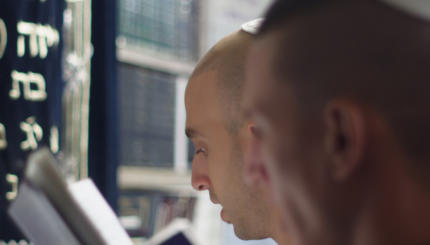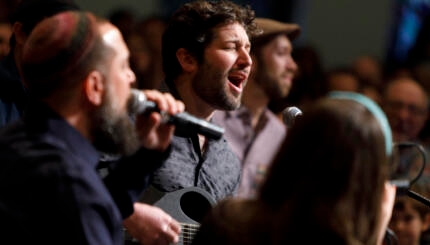Written in Aramaic, the Mourner’s is an almost 2,000-year-old prayer traditionally recited in memory of the dead. The prayer, which is included in all three daily prayer services and is recited in a minyan of at least 10 adult Jews, makes no mention of death. Instead, it is a prayer dedicated to praising God.
Find the text in Aramaic, transliteration and English translation here.
For whom does one say the Kaddish?
How frequently do Jewish mourners recite the Kaddish?

Help us keep Jewish knowledge accessible to millions of people around the world.
Your donation to My Jewish Learning fuels endless journeys of Jewish discovery. With your help, My Jewish Learning can continue to provide nonstop opportunities for learning, connection and growth.
For how long does a mourner say the Kaddish?
When did Jews begin reciting the Kaddish?
Why was this prayer designated by Jewish law to memorialize the dead?
Is there any reason to say the Kaddish if one is not religious?
Are there any alternative rituals for people who are unable to make it to services to say Kaddish?
What is it like to say Kaddish?
For whom does one say the Kaddish?
Traditionally, Jewish men are required to recite the Kaddish for a deceased parent, spouse, sibling or child. However, many women recite the Kaddish as well, and it is also permissible to do so for loved ones who are not parents, spouses, siblings or children.
How frequently do Jewish mourners recite the Kaddish?
Traditionally Jews recite Kaddish three times a day at the daily morning, afternoon and evening prayer services. However, Jews who say Kaddish have a range of practices — some people go to services daily to recite Kaddish, while others do so only on Shabbat. In some Reform congregations, the Kaddish is said even when a minyan is not present.
For how long does a mourner say the Kaddish?
Traditionally, Jews are required to say the Kaddish for 30 days after burial for a child, spouse or sibling, and for 11 months after burial for a parent. From then on, one recites Kaddish on a loved one’s yahrzeit (the Hebrew anniversary of their death) and at Yizkor (memorial) services.
When did Jews begin reciting the Kaddish?
This tradition dates back to the . The prayer was written in Aramaic, because it was the vernacular — the language spoken by most Jews at the time. In Nihum Aveilim: A Guide for the Comforter, Rabbi Stuart Kelman and Dan Fendel write that the prayer originally had nothing to do with mourning. Instead, it “was originally a call for the coming of God’s ultimate reign on earth” and was often said following a study session or sermon, and came to be known as the Rabbi’s Kaddish.
The Mourner’s Kaddish was originally known as the Orphan’s Kaddish and was said only by children for their parents, but now encompasses other mourners. There are also other forms of the Kaddish used in the daily prayers as well as a at funerals.
Why was this prayer designated by Jewish law to memorialize the dead?
There are many different theories, but no definitive answer. In Jewish Literacy, Rabbi Joseph Telushkin suggests that “Most likely, people believed that the finest way to honor the dead was to recite the Kaddish, thereby testifying that the deceased person left behind worthy descendants, people who attend prayer services daily and proclaim there their ongoing loyalty to God.”
Kelman and Fendel note that the “positive, affirming and hopeful nature of the text is in contradiction to the often negative, even depressed, outlook of a mourner, which is part of why recitation is so important.”
Since Judaism focuses on life, the tradition often sees death as a lessening of God’s presence in the world. The Kaddish prayer, as Rabbi Elie Kaunfer explains, asks for God’s presence to be made great in the world in the wake of grief and loss.
Can women say the Kaddish?
Outside of Orthodox Judaism, the answer is yes. In the Orthodox world, the issue is more complicated, with some communities supportive of women reciting the Kaddish and others objecting to it.
Learn more about women and Kaddish here.
Is there any reason to say the Kaddish if one is not religious?
Telushkin notes that reciting the Kaddish is psychologically beneficial because it gets mourners to go out in public and join a community. “After the death of a loved one, a person might well wish to stay home alone, or with a few family members, and brood. But saying Kaddish forces a mourner to join with others,” he writes.
Kelman and Fendel note: “Often, it is very difficult to know what to say to a mourner, and yet when the minyan responds with the appropriate words (at the same time that the mourner is standing), it is as if those words and the voices of those present offer comfort, since the mourner senses the presence of everyone around him or her.”
Saying Kaddish also can provide much-needed routine and structure in a life that has been upended by loss, and participating in a ritual Jews have been practicing for centuries gives one a feeling of being part of something larger.
Reciting Kaddish for a parent “gives the son or daughter an opportunity to receive communal sympathy for this entire time and even to channel his or her own bereftness into positive action,” writes Rabbi Judith Hauptman. “The need to attend services regularly often gives a new focus to the mourning child and fills a void left by the death of the parent, the community’s attention substituting in a certain way for parental attention no longer available to him or her.”
Are there any alternative rituals for people who are unable to make it to services to say Kaddish?
Rabbi Hauptman suggests reading a chapter from the or the Prophets or studying a passage from the or Talmud.
Some people also find Jewish meditation helpful during the mourning period.
You also may enjoy this alternative version of the Mourner’s Kaddish set to the tune of Adele’s “Hello”:
What is it like to say Kaddish?
Below are some personal essays and memoirs about saying Kaddish:
Lessons I Learned from Reciting Kaddish for Mom
Mayim Bialik on Mourning Her Father
Mournings and Mournings: A Kaddish Journal (E.M. Broner)
Living a Year of Kaddish: A Memoir (Ari Goldman)
Kaddish (Leon Wieseltier)
Listen to the Mourner’s Kaddish (via Mechon Hadar)
Sign up for a Journey Through Grief & Mourning: Whether you have lost a loved one recently or just want to learn the basics of Jewish mourning rituals, this 8-part email series will guide you through everything you need to know and help you feel supported and comforted at a difficult time.
Looking for a way to say Mourner’s Kaddish in a minyan? My Jewish Learning’s daily online minyan gives mourners and others an opportunity to say Kaddish in community and learn from leading rabbis.



